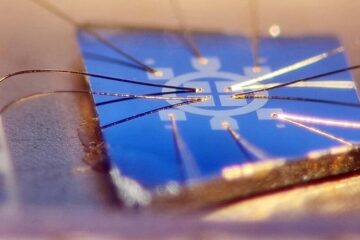Cancer support cells may evolve, fuel tumor growth, study shows

Findings suggest need to expand targets of new treatments
University of North Carolina at Chapel Hill scientists have demonstrated in a living organism that cancers may cause surrounding supportive cells to evolve and ultimately promote cancer growth.
The new research offers what is believed to be the first evidence that mutations within cancer cells can signal surrounding tissue cells to alter their molecular composition in ways that promote tumor growth and proliferation. Moreover, the findings also suggest that cell mutations that promote cancer progression may arise in cells other than the predominant cancer cell.
The new findings are published as the cover story in today’s (Dec. 16) issue of the journal Cell. While not offering immediate application to the treatment of human cancers, the research indicates that new anti-tumor therapies may be more effective if their targets are broadened to include molecules within supporting cells of the cancer. These additional target cells are in the tumor’s surrounding “microenvironment,” or stroma, including the supporting connective tissue that forms the framework of organs such as the breast, colon and prostate. They also are found in the tumor’s blood vessels, or its vasculature.
“Basically, virtually all the studies on genetic changes or changes in gene expression have focused on the cancer cell, on events within the cancer cell itself,” said Dr. Terry Van Dyke, professor of genetics and biochemistry and biophysics in the School of Medicine, member of the UNC Lineberger Comprehensive Cancer Center and the study’s senior author. Thus, research focused solely on the predominant cancer cell, such as epithelial cells that form the bulk of many tumors including breast cancer, would be on the accumulated mutations that have allowed the cell to survive and grow unchecked. “But over the last several years, it has become increasingly clear that cancer involves complex interactions among different types of cell compartments, and, as in any organ, these compartments comprise blood vessels, supporting tissue and immune cells,” said Van Dyke.
“The interaction between the predominant cancer cell type and other types of surrounding cells is important in the development of disease.”
The signals that go back and forth between cells contain selective pressures, not only on the cancer cell itself but also on the surrounding cell, she said.
“Think of it as a microcosm of evolution, such that every change that goes on in the cancer cell can impact cells around it. It’s a back-and-forth cross-talk via which the whole entity evolves, not just a subset of cells within the cancer. It’s an environment where changes in the surrounding cells are selected that will help tumor growth.”
Van Dyke’s UNC collaborators in the new research were graduate student Reginald Hill and postdoctoral researcher Dr. Yurong Song. Dr. Robert D. Cardiff, professor of pathology at the University of California at Davis, also collaborated in the study.
Their series of experiments involved a genetically engineered mouse model of prostate cancer developed in Van Dyke’s UNC laboratory. The researchers manipulated epithelial cells – the target cell type for prostate cancer – causing them to divide at an accelerated rate.
First, they found that this accelerated division triggered a signal to fibroblasts, connective cells in the surrounding supporting tissue, to grow and proliferate. The signal then induced a tumor suppressor, p53, within the fibroblasts, which stopped this action.
Thus, a change made only in epithelial cells had an impact on surrounding tissue cells.
Next, the researchers showed that fibroblasts eventually lost p53 function. This resulted in cells continuing to divide and proliferate, thereby fueling the cancer’s growth. “This occurred in 100 percent of the animals studied. It’s a strong selective pressure,” Van Dyke said. “Now the whole organ is evolving as a cancer, not just a single population of cells.” If the research suggests a need to look at cancer development as a more dynamic process, it also indicates a need for expanding the approach to treatment, said Van Dyke.
“If the changes you’re targeting in the predominant cancer cell are going to affect, say, the supportive tissue, it may be best to develop therapies that hit both types of cell.”
In their report, the study authors said further work aimed at more fully understanding the signals, their pathways and the cells’ responses was needed.
They said their findings underscore the dynamic complexity of cell-to-cell interactions and the changing selective microenvironment that drives cancer development.
Media Contact
More Information:
http://www.med.unc.eduAll latest news from the category: Life Sciences and Chemistry
Articles and reports from the Life Sciences and chemistry area deal with applied and basic research into modern biology, chemistry and human medicine.
Valuable information can be found on a range of life sciences fields including bacteriology, biochemistry, bionics, bioinformatics, biophysics, biotechnology, genetics, geobotany, human biology, marine biology, microbiology, molecular biology, cellular biology, zoology, bioinorganic chemistry, microchemistry and environmental chemistry.
Newest articles

Next-generation treatments hitch a ride into cancer cells
Researchers from Osaka University discover that opening a channel into cancer cells helps antisense oligonucleotide drugs reach their targets. Antisense oligonucleotides (ASOs) are next-generation drugs that can treat disease by…

Boron deficiency: oilseed rape reacts as with infection and pest infestation
Genetic mechanisms uncovered… Boron deficiency has a devastating effect on oilseed rape and related plants. However, little is known about the underlying genetic mechanisms. A study shows that the response…

Quantum Precision: A New Kind of Resistor
Researchers at the University of Würzburg have developed a method that can improve the performance of quantum resistance standards. It´s based on a quantum phenomenon called Quantum Anomalous Hall effect….





















